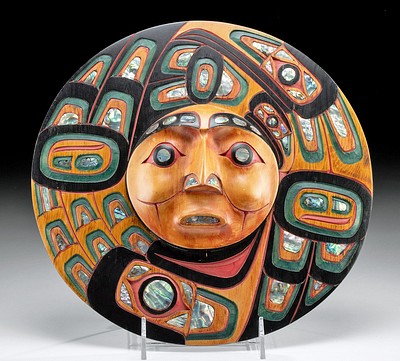Egyptian Middle Kingdom Faience Nude Concubine
Lot 1a
About Seller
Artemis Gallery
686 S Taylor Ave, Ste 106
Louisville, CO 80027
United States
Selling antiquities, ancient and ethnographic art online since 1993, Artemis Gallery specializes in Classical Antiquities (Egyptian, Greek, Roman, Near Eastern), Asian, Pre-Columbian, African / Tribal / Oceanographic art. Our extensive inventory includes pottery, stone, metal, wood, glass and textil...Read more
Categories
Estimate:
$1,800 - $2,500
Absentee vs Live bid
Two ways to bid:
- Leave a max absentee bid and the platform will bid on your behalf up to your maximum bid during the live auction.
- Bid live during the auction and your bids will be submitted real-time to the auctioneer.
Bid Increments
| Price | Bid Increment |
|---|---|
| $0 | $25 |
| $300 | $50 |
| $1,000 | $100 |
| $2,000 | $250 |
| $5,000 | $500 |
| $10,000 | $1,000 |
| $20,000 | $2,500 |
| $50,000 | $5,000 |
| $100,000 | $10,000 |
| $200,000 | $20,000 |
About Auction
By Artemis Gallery
Dec 7, 2023
Set Reminder
2023-12-07 10:00:00
2023-12-07 10:00:00
America/New_York
Bidsquare
Bidsquare : Fine Antiquities, Ancient & Pre-Columbian Art
https://www.bidsquare.com/auctions/artemis-gallery/fine-antiquities-ancient-pre-columbian-art-14361
Classical antiquities, ancient, and ethnographic art from cultures encompassing the globe. Egyptian, Greek, Roman, Etruscan, Near Eastern, Asian, Pre-Columbian, Native American, African / Tribal, Oceanic, Spanish Colonial, Fine / Visual Arts, so much more! Artemis Gallery info@artemisgallery.com
Classical antiquities, ancient, and ethnographic art from cultures encompassing the globe. Egyptian, Greek, Roman, Etruscan, Near Eastern, Asian, Pre-Columbian, Native American, African / Tribal, Oceanic, Spanish Colonial, Fine / Visual Arts, so much more! Artemis Gallery info@artemisgallery.com
- Lot Description
Ancient Egypt, Middle Kingdom, 11th to 13th Dynasty, ca. 2130 to 1650 BCE. A rare and exceptionally old example of a hand-built faience female figure, nude and covered in turquoise-hued glaze, with arms held loosely at her sides. Dozens of hand-painted black stripes cover her body, perhaps scarification or painted tattoos, while additional black pigment emphasizes her enormous eyes and bag-shaped coiffure. Though figures like this example were typically identified as "concubines" and buried with men in ancient Egypt - as it was believed to ensure the man's fertility and sexual pleasure in the afterlife - scholars now posit these figures as fertility symbols kept by both men and women to enhance one's fertility/virility, even in the afterlife. Size: 1.18" L x 1.83" W x 3.12" H (3 cm x 4.6 cm x 7.9 cm); 4.75" H (12.1 cm) on included custom stand.
Exhibited periodically in the Robert and Frances Fullerton Museum of Art (RAFFMA), California State University, San Bernardino from 1998 to 2023.
Cf. The Metropolitan Museum of Art, accession number 02.200.18
Provenance: Collection of Dr. W. Benson Harer, Los Angeles, California, USA, acquired from Galerie Cybele, Paris, France, May 5, 1994; Exhibited periodically in the Robert and Frances Fullerton Museum of Art (RAFFMA), California State University, San Bernardino from 1998 to 2023.
All items legal to buy/sell under U.S. Statute covering cultural patrimony Code 2600, CHAPTER 14, and are guaranteed to be as described or your money back.
A Certificate of Authenticity will accompany all winning bids.
We ship worldwide and handle all shipping in-house for your convenience.
#182256Loss to lower half of body as shown. Abrasions, light fading to glaze, and a couple of stable hairline fissures, otherwise in excellent condition. Great feminine form, and nice preservation to glaze in most areas.Condition
- Shipping Info
-
All shipping is handled in-house for your convenience. Your invoice from Artemis Gallery will include shipping calculation instructions. If in doubt, please inquire BEFORE bidding for estimated shipping costs for individual items.
-
- Buyer's Premium



 EUR
EUR CAD
CAD AUD
AUD GBP
GBP MXN
MXN HKD
HKD CNY
CNY MYR
MYR SEK
SEK SGD
SGD CHF
CHF THB
THB














